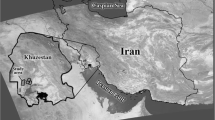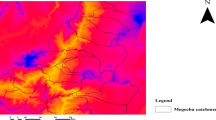Abstract
Reference evapotranspiration (ETO) estimation is a prerequisite for the estimation of evapotranspiration rates of different crops. There is global consensus on the consistency of the FAO-56 Penman–Monteith (FAO-56 PM) method, and it has lately become the first-choice for the estimation of ETO, but despite its consistent performance, other methods continue to be popular for their simple structure and data requirement, more so in field practice. In this study, regression models were developed for predicting monthly ETO using monthly averages of minimum temperature (Tmin), relative humidity (RH), wind speed (WS), and sunshine hours (SSH) for three stations in the temperate Kashmir Valley. The models are based on the ETO data generated using the FAO-56 PM method. The weather data required for the analysis were for a period of 20 years. The models were evaluated using the coefficient of determination (R2) and residual analysis. R2 values for the developed models were greater than 0.96. In addition to the ETO estimation, the developed models may also be used for trend evaluation in the ETO data in climatologically similar regions. In this study, for the cases of very limited data availability where the FAO-56 PM equation cannot be used, the Hargreaves and Samani (HAR) equation, which only uses temperature as an input, was calibrated for each station using linear regression between FAO-56 PM ETO and HAR ETO.






Similar content being viewed by others
Code availability
Not applicable.
References
Allen RG, Clemmens AJ, Burt CM, Solomon K, O’Halloran T (2005) Prediction accuracy for project wide evapotranspiration using crop coefficients and reference evapotranspiration. J Irrigat Drain Eng 131:24–36
Allen RG, Pereira LS, Raes D, Smith M (1998) Crop evapotranspiration. Irrigation and Drainage Paper No. 56. FAO and United Nations: Rome, Italy; 300 pp
Allen RG, Pruitt WO, Wright JL, Howell TA, Ventura F, Snyder R, Itenfisu D, Steduto P, Berengena J, Beselga J, Smith M, Pereira LS, Raes D, Perrier A, Alves I, Walter I, Elliott R (2006) A recommendation on standardized surface resistance for hourly calculation of reference ETO by the FAO56 Penman-Monteith method. Agric Water Manag 81:1–22
Bandyopadhyay A, Bhadra A, Swarnakar RK, Raghuwanshi NS, Singh R (2012) Estimation of reference evapotranspiration using a user-friendly decision support system: DSS_ET. Agric For Meteorol 154:19–29
Cristea NC, Kampf SK, Burges SJ (2013) Linear models for estimating annual and growing season reference evapotranspiration using averages of weather variables. Int J Climatol 33:376–387
Garcia M, Raes D, Allen R, Herbas C (2004) Dynamics of reference evapotranspiration in the Bolivian highlands (Altiplano). Agric For Meteorol 125:67–82
Hargreaves GH, Samani ZA (1985) Reference crop evapotranspiration from temperature. Appl Eng Agric 1:96–99
Irmak S, Allen RG, Whitty EB (2003a) Daily Grass and alfalfa-reference evapotranspiration estimates and alfalfa to grass evapotranspiration ratios in Florida. J Irrigat Drain Eng 129:360–370
Irmak S, Irmak A, Allen RG, Jones JW (2003b) Solar and net radiation- based equations to estimate reference evapotranspiration in humid climates. J Irrigat Drain Eng 129:336–347
Jabloun M, Sahli A (2008) Evaluation of FAO-56 methodology for estimating reference evapotranspiration using limited climatic data, application to Tunisia. Agric Water Manag 95:707–715
Kashyap PS, Panda RK (2001) Evaluation of evapotranspiration estimation methods and development of crop-coefficients for potato crop in a sub- humid region. Agric Water Manag 50:9–25
Kovoor G, Nandagiri L (2007) Development of regression models for predicting pan evaporation from climatic data – a comparison of multiple least-squares, principal components and partial least squares approaches. J Irrigat Drain Eng 133:444–454
O’Brien RM (2007) A caution regarding rules of thumb for variance inflation factors. Qual Quant 41:673–690
Temesgen B, Eching S, Davidoff B, Frame K (2005) Comparison of some reference evapotranspiration equations for California. J Irrigat Drain Eng 131:73–84
Xu CY, Singh VP (2001) Evaluation and generalization of radiation-based methods for calculating evaporation. Hydrol Process 15:305–319
Yirga SA (2019) Modelling reference evapotranspiration for Megecha catchment by multiple linear regression. Model Earth Syst Environ 5:471–477
Acknowledgements
Acknowledgments are due to the Ministry of Human Resources Development (MHRD), Government of India, for providing the Doctoral Fellowship to the author, IMD Pune, for providing the meteorological data and to NIT Srinagar for providing space for computational analysis.
Funding
The research is funded by the Ministry of Human Resources Development (MHRD), Government of India.
Author information
Authors and Affiliations
Corresponding author
Ethics declarations
Conflict of interest
The authors declare that there is no conflict of interest.
Availability of data and material
The data that support the findings of this study are available from IMD PUNE. Restrictions apply to the availability of these data, which were used under license for this study. Data are available from the authors with the permission of IMD PUNE.
Additional information
Publisher's Note
Springer Nature remains neutral with regard to jurisdictional claims in published maps and institutional affiliations.
Rights and permissions
About this article
Cite this article
Mohsin, S., Lone, M.A. Modeling of reference evapotranspiration for temperate Kashmir Valley using linear regression. Model. Earth Syst. Environ. 7, 495–502 (2021). https://doi.org/10.1007/s40808-020-00921-8
Received:
Accepted:
Published:
Issue Date:
DOI: https://doi.org/10.1007/s40808-020-00921-8




